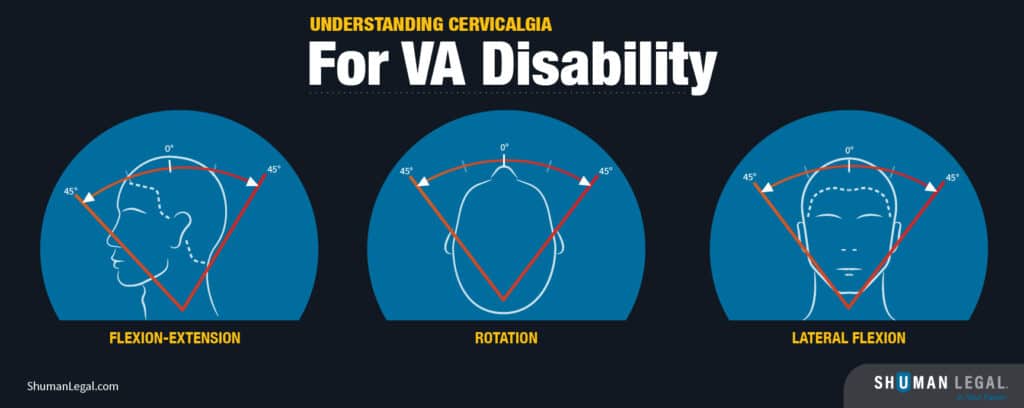
Understanding your cervicalgia VA rating is crucial for securing the disability benefits you deserve for chronic neck pain. We’ll provide you with the straightforward criteria and clear-cut steps to navigate the VA system effectively, ensuring you’re well-equipped to maximize your rating.
Key Takeaways
- Cervicalgia, or chronic neck pain, is recognized by the VA as a disability that may be compensated if service-connected, with severity ranging from mild discomfort to severe pain and functional impairment.
- Eligibility for VA disability benefits for neck pain requires veterans to provide medical evidence linking their cervicalgia to their military service and demonstrate a chronic pain condition causing functional limitations.
- The VA uses the General Rating Formula for Diseases and Injuries of the Spine to determine cervicalgia disability ratings, with evaluations based on the impact of symptoms on movement and range of motion, and secondary conditions like radiculopathy and degenerative disc disease may also affect ratings.
Your search for help ends here. Let’s get started, for FREE.
Understanding Cervicalgia and Its Impact on Veterans
Cervicalgia, a medical term, refers to chronic neck pain. This pain can vary in intensity and duration. Discomfort in the neck may arise suddenly after an injury, or gradually develop over time due to a disease. Veterans are particularly susceptible to cervicalgia due to the physical demands of military service, often leading to injury and strain to the neck and spinal cord. Some common causes of cervicalgia include:
- Muscle strain or tension
- Whiplash
- Herniated disc
- Arthritis
- Spinal stenosis
- Degenerative disc disease
If you are experiencing severe neck pain or chronic neck pain, it is important to consult with a healthcare professional for an accurate diagnosis and appropriate treatment of neck pain conditions.
The Veterans Affairs (VA) recognizes neck pain, or cervicalgia, as a disability eligible for compensation if it is caused by military service. This recognition means that many veterans suffering from chronic neck pain can apply for disability benefits, but navigating the claims process can be challenging without a clear understanding of the condition and its impact.
Causes of Cervicalgia in Veterans
Cervicalgia in veterans can result from various factors, including:
- Military training
- Accidents
- Carrying heavy loads
- High-impact events, such as explosions and car accidents
These are particularly prevalent causes of neck injuries among veterans.
Moreover, there are several recognized causes of neck pain for veterans, including:
- Maintaining a hunched position for extended periods
- Engaging in service-related activities such as heavy lifting and operating weapons, which can cause muscle strain and cervicalgia
- Cervical kyphosis, often related to military service and sometimes referred to as ‘military neck’
These factors can contribute to neck pain and discomfort in veterans.
Symptoms and Complications
The symptoms of cervicalgia can range from mild discomfort to severe pain, affecting a person’s quality of life significantly. Some common symptoms of cervicalgia include:
- Neck pain
- Extreme instability
- Headaches
- Chest pressure or pain
In severe cases, veterans may experience these symptoms.
If not adequately managed, cervicalgia can lead to more severe symptoms such as swollen glands and complications that further affect a person’s daily life. Understanding these symptoms is crucial to provide the necessary medical evidence when claiming VA disability benefits.
Were You Denied Veteran Benefits?
VA Disability Benefits for Neck Pain: Eligibility Criteria
Veterans who suffer from chronic neck pain due to their military service may be eligible for VA disability benefits. However, to qualify, certain criteria must be met. For instance, a veteran must demonstrate that their neck pain is directly connected to their military service. A formal diagnosis of a related condition is not always necessary for a disability rating if chronic neck pain can be shown to be service-connected.
Claims for cervicalgia can be denied if the veteran fails to provide evidence that establishes a service connection for neck pain. To substantiate a VA disability claim for neck pain, veterans must present medical evidence demonstrating their condition and its link to service. Securing expert opinions from medical professionals can considerably strengthen a VA disability claim by formally associating the neck pain with military service.
Establishing Service Connection
Establishing a service connection for neck pain is a crucial step in the VA disability claim process. To establish a service connection, veterans must prove that their condition was incurred or aggravated during military service, even if it’s a pre-existing condition worsened by service.
To document the service connection, veterans need evidence such as medical records, service records documenting incidents, and potentially statements from peers to demonstrate an event during service causing or exacerbating the neck pain. Veterans must show chronic neck pain that leads to functional impairment, as the VA does not compensate for transient neck issues; evidence supporting the service connection must not hinge solely on subjective reports of pain.
Medical Evidence Requirements
When applying for VA disability benefits for neck pain, veterans need to submit significant medical documentation. Diagnostic records, treatment history, and a physical examination are central pieces of medical documentation needed for a cervicalgia VA claim. Veterans can also provide additional support for their claim with lay statements detailing the disability’s impact on daily life, buddy statements from fellow service members, and military records related to the causative incident.
While a formal diagnosis is not always required, there must be an underlying pathologic abnormality associated with the pain for the disability to be compensable. Evidence proving that neck pain causes functional impairment or loss and is not purely subjective is crucial to validating the claim and maximizing the disability rating.
VA Rating System for Cervicalgia
The VA rating system for cervicalgia is based on the General Rating Formula for Diseases and Injuries of the Spine, which can result in a rating from 10 percent to 100 percent. When determining a cervicalgia rating, the VA takes into account factors such as the severity of symptoms and their impact on movement or range of motion. This evaluation helps ensure appropriate support for those affected..
The severity of cervicalgia can cause a varied degree of functional loss, with intense muscle spasms leading to substantial functional impairment, which is a determining factor in the VA rating. The primary basis for rating neck pain severity is through range of motion measurements, which correlate to different percentages of disability ratings.
General Rating Formula for Spine Conditions
The General Rating Formula for Spine Conditions is used to evaluate spinal conditions, including cervicalgia. The formula has been revised to specifically consider symptoms such as pain, stiffness, or aching in the evaluation of spinal conditions.
A 10-percent disability evaluation is assigned when there is a vertebral body fracture with a loss of 50 percent or more of the height, impacting the spinal condition and resulting in an abnormal spinal contour.
Range of Motion Measurements

- Forward flexion
- Extension
- Lateral flexion
- Rotation of the head
A goniometer should be used for precise measurement at the C&P exam, with each reading rounded to the nearest five degrees for the evaluation. The degree of mobility limitation measured during the exam is a critical factor in determining a veteran’s VA disability rating for neck pain. Pain experienced during range of motion testing can be used to inform the VA rating for cervicalgia.
Secondary Conditions Related to Cervicalgia
In addition to the primary conditions linked to cervicalgia, certain secondary conditions can also affect a veteran’s VA disability rating. Conditions such as migraines and radiculopathy related to cervicalgia can increase a veteran’s VA disability rating if they are properly documented. There are several secondary conditions that can lead to a higher VA disability rating for neck pain. These may include changes in walking, problems with eating, or challenges with swallowing.
Radiculopathy
Radiculopathy, a common secondary disability related to neck pain, is often associated with cervicalgia. It is important to seek medical attention for proper diagnosis and treatment. This condition affects the:
- Neck
- Shoulders
- Arms
- Hands
It results from nerve compression in the entire spine, particularly in the entire cervical spine, often caused by cervical bone spurs and muscle spasm.
Veterans may receive a rating for radiculopathy as a secondary VA disability claim, associated with service-connected conditions of neck, shoulder, and back.
Degenerative Disc Disease
Degenerative disc disease is another condition often associated with cervicalgia. Intense activities during military service can exacerbate neck wear and tear, contributing to the development of degenerative disc disease. This condition may result in:
- Back pain
- Muscle weakness
- Pinched nerves
- Pain that intensifies with certain activities, but may be relieved by walking or changing positions.
The VA rates degenerative disc disease using va disability ratings, which range from 10% to 100%, with assessments based on the frequency, intensity, and duration of symptoms.
The C&P Exam for Neck Pain
The Compensation and Pension (C&P) exam is an assessment of a veteran’s neck pain to establish a potential connection to an in-service event. A C&P exam includes asking questions about the veteran’s condition and performing a physical examination to assess the extent of the neck pain.
The C&P exam process involves testing the veteran’s range of motion and identifying painful points to evaluate the current state of the condition.
Preparing for the Exam
Before attending the C&P exam, veterans should compile all medical records related to their neck pain, including any associated conditions. Comprehensive medical evidence such as VA and non-VA treatment records, diagnostic test results, and medical experts’ opinions will contribute to a stronger cervicalgia VA claim.
Veterans are advised to be ready to detail the inception of their neck pain, describe its effects on their daily activities, and any secondary health issues that have emerged.
Understanding the Examiner’s Opinion
The examiner’s opinion during the C&P exam can significantly influence the outcome of a veteran’s claim, directly impacting the VA rating for cervicalgia. The VA often discredits opinions from the C&P examiners that lack adequate reasoning, highlighting the necessity for the examiner to provide a detailed rationale for their conclusions.
C&P examiners, as well as independent providers, are required to consider and give weight to the veteran’s self-reported symptoms during the physical evaluation for neck conditions.
Were You Denied Veteran Benefits?
Appealing a Denied or Low-Rated Claim
If a veteran receives a low rating or denial for their neck pain VA disability claim, they have the right to appeal. Veterans can appeal the decision within twelve months or file a Supplemental Claim. Successful appeals can result in the award of VA benefits, including retroactive benefits, making it worthwhile for veterans to pursue an appeal if they believe their claim was unfairly evaluated.
Common Reasons for Denial
Common reasons for denying cervicalgia-related claims include insufficient service connection and lack of formal diagnosis. In such cases, veterans may seek legal assistance to better navigate the VA disability rating system and increase their chances of overturning a denied claim.
Steps to Appeal a Decision
Veterans can choose between three different appeal routes for a denied claim: Supplemental Claim, Higher-Level Review, or Board Appeal. Each route has its own requirements and processes that veterans need to understand to make an informed decision.
Tips for Maximizing Your Cervicalgia VA Rating
To maximize a cervicalgia VA rating, several strategies can be employed. Demonstrating the functional impairment and interference of neck pain with daily activities is crucial for a successful VA claim outcome. Veterans can obtain referrals for private medical experts from attorneys well-versed in Social Security, workers’ compensation, or negligence cases.
Including the impact of secondary conditions related to cervicalgia is essential in maximizing the VA disability rating.
Seeking Expert Opinions
Expert opinions from medical professionals can significantly strengthen a VA claim by providing authoritative evidence of the service connection and severity of cervicalgia. Veterans should seek opinions from experts who specialize in neck pain and spinal disorders and who have experience dealing with VA claims to ensure that the opinion is well-informed and relevant.
Documenting Secondary Conditions
Documenting secondary conditions is crucial for strengthening a VA disability claim related to cervicalgia. Conditions such as depression, frequently observed as a comorbidity in veterans who experience chronic conditions like cervicalgia, should be included in the documentation.
Frequently Asked Questions
What is the range of motion for a VA disability neck?
For VA disability rating of the neck, the range of motion for a 10% disability rating is between 30 and 45 degrees for flexion, or between 175 and 340 degrees for combined range of motion. For a 20% rating, flexion is between 15 and 35 degrees, or the combined range of motion is less than or equal to 170 degrees.
What is the highest VA disability rating for neck pain?
Neck pain can be rated up to 100% depending on the limitation in range of motion and the severity of the condition, including any resulting functional loss due to painful motion.
Is cervicalgia considered a disability?
Yes, cervicalgia can be considered a disability, and you may qualify for SSDI or SSI benefits if your symptoms are severe and meet the specific criteria outlined by Social Security listing 1.15 (C). Proper medical documentation is essential in this process.
What is the VA rating code for cervicalgia?
The VA rating code for cervicalgia is 5237, which corresponds to the diagnostic code for cervical strain. This code is used to assess disability ratings for cervical strain.
What is cervicalgia and how is it related to veterans?
Veterans are at a higher risk of cervicalgia, a condition characterized by chronic neck pain, because of the physical demands of military service, which often lead to injury and strain to the neck and spinal cord. This can result in sudden pain from injury or the development of neck pain over time as a disease.














